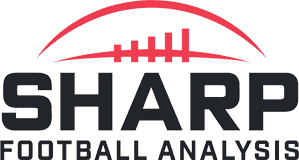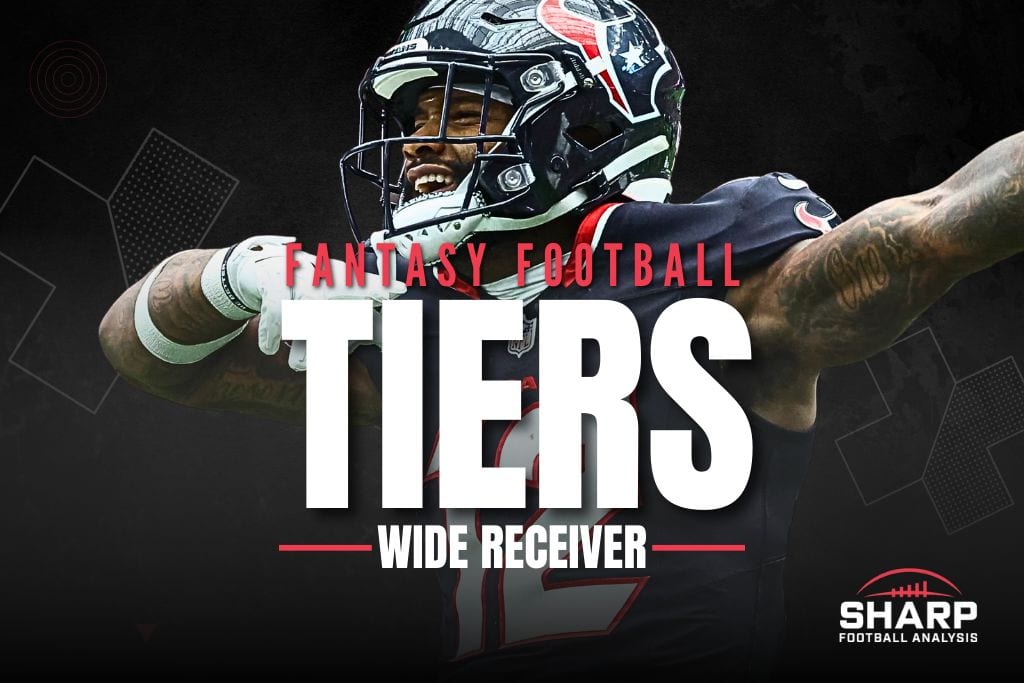One remaining obstacle we still face in the fantasy community, as both content providers and consumers, is understanding that rankings, projections, tiers, and average draft positions serve different purposes and are not interchangeable.
I penned an offseason lead covering projections and their application, which you can review here.
While those projections give us a range of season long production and have implications for listing players in a linear format (rankings), even when those full season numbers are accurate, they fail to capture the overall weekly impact and the pockets of production that are relevant to our weekly game of fantasy football.
There are very few players at each position that smash weekly throughout the fantasy season at the highest level, and we are hopeful to be in on the remainder of players when they strike the hottest.
That is where player tiers come in.
Click Here to Find Out How to Get Our Draft Kit for FREE!
Buy the Fantasy Football Draft Kit
Many player tiers available are simply rankings divided into sections.
While the rankings are more focused on a probable tally of season long output for a week to week game, I prefer to structure my tiers based on how similarly players accrue their fantasy points and by player archetypes.
By doing this, I can identify actionable gaps in player pricing per tier, which in turn allows for arbitrage in fantasy drafts while also highlighting some longer-odds players who have more potential than initially perceived.
Arbitrage in fantasy football is driven strongly by how production is accrued, and the order of those players (rankings) is driven by the opportunities (on a player and team level) that each player receives.
Our projections are inherently going to be wrong on those projected opportunities often.
A multitude of factors influence team situations.
Game script, injuries to a player himself, injuries to surrounding teammates, ineffective play, player breakouts, and so on.
That is just the game through injuries, performance variance, and fluctuation.
Understanding how a player is used enables us to identify prospects to buy into the variance in his performance across opportunities.
If we are wrong on the opportunity projection, then a lower-tiered player could be an arbitrage opportunity.
While there is no direct overlap with the individual player rankings, the order of these tiers reflects how I prioritize drafting positions from an archetypal stance.
While that may be confusing for a player ranked highly on a linear list versus a specific tier he is in, I will do my best to incorporate detailed thoughts regarding draft capital in those events throughout the player breakdowns.
One final note: I will be updating and adding analysis to these tiers throughout the summer.
With that introduction to the methodology used, let's proceed to the actual player analysis.
Tier 1 Fantasy Football WRs:
- Ja’Marr Chase
- CeeDee Lamb
- Puka Nacua
- Justin Jefferson
- Amon-Ra St. Brown
- Nico Collins
- Drake London
- Malik Nabers
- Brian Thomas Jr.
- A.J. Brown
We are kicking things off with the wideouts who I believe have the best odds to compete for being the WR1 in overall scoring this season.
We have had a different WR1 overall in eight straight seasons.
What is even more unique about that is that the WR1 overall has also been eight different players over that run in PPR formats.
In standard leagues, we have had nine straight different WR1 scoring leaders.
The other fun part about that is that none of those wide receivers carried an ADP as WR1 in drafts that season.
The last time that the WR1 in ADP finished as the highest scorer overall in PPR formats was Antonio Brown in 2017.
In standard leagues, you have to go back to Brown in 2015 to find the WR1 in ADP leading the year in points scored.
We have been getting consistent churn at the top of the position.
So even though Ja’Marr Chase is the consensus WR1, we inherently know that the field can compete.
Ja’Marr Chase
Bye: Week 10
Chase has finished as a WR1 in points per game in all four seasons to open his career, but his usage has changed from downfield maven to full field wideout.
He was sensational again in 2024, leading the NFL in receptions (127), receiving yards (1,708), and touchdowns (17).
He had a league-high 9 touchdowns on throws that were not in the end zone.
Since entering the league, Chase has a league-best 25 of those touchdowns.
He also received a bump in the absence of Tyler Boyd from the offense, getting more full field target opportunities.
Ja’Marr Chase Career Usage Rates
| Year | Early Down Tgt% | Behind% | ShortTgt% | InterTgt% | DeepTgt% | Slot% |
|---|---|---|---|---|---|---|
| 2021 | 23.0% | 12.2% | 44.5% | 19.5% | 23.8% | 14.3% |
| 2022 | 21.5% | 14.7% | 47.0% | 25.4% | 12.9% | 20.6% |
| 2023 | 25.6% | 24.1% | 41.4% | 20.7% | 13.8% | 24.8% |
| 2024 | 29.2% | 14.9% | 54.3% | 19.4% | 11.4% | 32.2% |
With the loss of Boyd from the offense, Chase continued to raise his slot usage. That in turn got him much more involved in the offense on early downs.
Chase was third at the position in early down target share, trailing only Malik Nabers (32.9%) and Justin Jefferson (29.7%).
He also led the NFL with 21 targets in the end zone.
Chase was also impacted positively by the availability of Tee Higgins, something we covered with Joe Burrow in the quarterback tiers.
With Higgins on the field, Chase averaged 2.54 yards per route, 14.2 yards per catch, and 9.1 air yards per target.
With Higgins off the field, Chase averaged 2.22 yards per route, 12.2 yards per catch, and 8.2 air yards per target.
We expect some regression in terms of counting stats for the Bengals passing game compared to a year ago, but on the surface, not much has changed in their top down layout.
This is still a team with a questionable defense and an offensive line that will likely rely on their passing game to push the action.
The Bengals threw the football 9% more than expected last season and 4% more than expected on first downs.
Even with some anticipated shaving off the top from last year’s output, they are going to throw it a lot compared to the league average.
CeeDee Lamb
Bye: Week 10
A high-end WR1 in three straight seasons, Lamb has had over 100 receptions in three consecutive years.
Lamb once again carried the Dallas passing game, catching 101 passes for 1,194 yards and 6 touchdowns over 15 games.
Lamb accounted for 32.3% of the Dallas targets when he was on the field, which was seventh among wide receivers.
He averaged 6.7 receptions (6th) for 79.6 yards per game (8th) despite working for half the year with backup quarterback play.
Lamb was hurt by the absence of Dak Prescott, averaging a career-worst 11.8 yards per catch.
With Prescott off the field, Lamb averaged only 10.9 yards per catch
His depth of target went from 8.6 yards downfield with Prescott to 7.0 yards without him.
Despite the pedestrian usage impacted by quarterback play, Lamb was still excellent on his merit.
He averaged 3.52 yards per route against man coverage, which was third in the league.
Lamb missed two games and still had 73 more targets than the next closest wide receiver on the roster.
Even with the addition of George Pickens, Lamb has room to shed some overall targets and remain at the front of the league.
Puka Nacua
Bye: Week 8
Nacua has opened his career as the WR6 and WR3 in fantasy points per game.
After returning in Week 8 from an early season knee injury, Nacua averaged 7.5 receptions for 95.5 yards per game over that stretch with 3 touchdowns receiving.
He led all wide receivers with a target on 38.3% of his routes with 3.57 yards per route run.
That is the highest target rate for a wide receiver running 100-plus routes in a season over the past 10 years.
Nacua had a gaudy 41.1% of the team’s targets when he was on the field.
Part of why Nacua’s target share jumped to all-time highs was the decline of Cooper Kupp to close the season.
The addition of Davante Adams is an upgrade on paper, but Nacua has such lofty target rates that he can share work while remaining at the top of the league in targets.
He was targeted on 37.7% of his routes with three or more wide receivers on the field. The next closest receiver was at 29.1%.
No team leaned on its wide receivers more than the Rams last season.
They targeted their wide receivers at a league-high 74.5% rate.
If there is one slice of shade to throw Nacua’s way, it is that he has not found the end zone at a high rate to open his career.
He has 9 receiving touchdowns over 28 regular season games.
When Nacua has been on the field with Kupp the past two seasons, he was out-targeted in the end zone (13 to 12) while Demarcus Robinson also matched him in end zone targets.
This is an area where Adams can make a significant impact, as he is a proven asset in the red zone.
That last component can ding Nacua in non-PPR formats, but his first two years in the NFL are plenty of signal that this is a receiver worth front end investment.
Justin Jefferson
Bye: Week 6
Jefferson has opened his career with five straight seasons as WR9 or better in points per game.
No player has more receiving yards through five years than Jefferson.
Jefferson had another incredible season in 2024.
He caught 103 passes (WR4) for 1,533 yards (WR4) and 10 touchdowns (WR5).
Jefferson had 29.8% of Minnesota targets (WR2) with 2.51 yards per route (WR4).
He was second at the position in target share on early downs (29.7%).
He led all receivers in yards per team pass attempt (2.80), the best rate of his career.
Last season provided further insulation for Jefferson as a fantasy asset, but we have more moving parts again this season.
The transition to J.J. McCarthy adds an unknown component to the equation when paying top dollar.
Minnesota has provided ample signals that they are going to plan to insulate McCarthy with a better run game.
This offseason, Minnesota has extended Aaron Jones, traded for and extended Jordan Mason, signed Will Fries and Ryan Kelly in free agency, used a first-round pick on Donovan Jackson, and extended Josh Oliver.
Jefferson ran 35.9 routes per game last season (WR15), which was his lowest total since his rookie season.
If Minnesota can run the ball as much as they are signaling, that could force Jefferson to remain hyper-efficient, attached to a quarterback with no regular season pass attempts so far.
He has delivered on that front so far, but it is an added variable.
Amon-Ra St. Brown
Bye: Week 8
St. Brown had another strong campaign in 2024, catching 115 passes for 1,263 yards and a career-high 12 touchdowns.
Only CeeDee Lamb has more receptions (343) than St. Brown (340) over the past three seasons, with St. Brown finishing as the WR11, WR4, and WR5 in points per game.
St. Brown ended the season with 27% of the Detroit targets, fifth among wide receivers.
He picked things up to close the year.
After averaging 58.2 yards per game through nine games, St. Brown posted 92.4 per game over his final eight games.
He had one game below 60 yards over that span after clearing 60 yards only three times through nine weeks.
St. Brown ultimately got there in the end for fantasy gamers, but his usage was impacted by Detroit incorporating more pieces into their offense.
He ended the year WR11 in expected points per game, with his lowest target rate per route (25.7%) since his rookie season.
If looking at St. Brown’s opening four seasons, his 2023 season looks like his ceiling in terms of usage, but he has run hot in the scoring department compared to the opening of his career.
| Year | Rec/Gm | ReYd/Gm | TD% | TmRec% | TmYd% | TmTD% |
|---|---|---|---|---|---|---|
| 2021 | 5.3 | 53.6 | 4.2% | 22.7% | 23.5% | 21.7% |
| 2022 | 6.6 | 72.6 | 4.1% | 27.7% | 26.2% | 20.7% |
| 2023 | 7.4 | 94.7 | 6.1% | 29.2% | 32.9% | 33.3% |
| 2024 | 6.8 | 74.3 | 8.5% | 28.8% | 26.8% | 30.8% |
We have already discussed this with Jared Goff, but we expect the touchdown count for Detroit to drop in 2025 after they scored 18 more touchdowns than expected.
St. Brown scored 3.7 more touchdowns than expected last year.
We also found out that St. Brown needed to have “cleanup” surgery for a knee injury.
He is expected to be ready for training camp, but that is just one more thing to add here.
All of that said, St. Brown is a proven asset that you are not going to go broke with.
Even if he does lose some touchdowns, this is a player you can count on for a high floor paired with the ultimate runout that he could lead the league in receptions.
If Detroit faces a tougher schedule, there is a possibility that St. Brown will receive more opportunities for scoring targets.
The Lions had a 54.1% dropback rate in the second half of games (26th) last season, despite leading for 64% of their second half snaps (third).
Nico Collins
Bye: Week 6
Collins caught 68 passes for 1,006 yards and 7 touchdowns over 12 games last season.
A midseason hamstring injury slowed him down from the blistering pace he opened the year with.
He had one 100-yard game after returning in Week 11 after going over 100 yards in three of the first five games last season.
However, he still managed to post 2.87 yards per route run last season, third among wide receivers behind Puka Nacua (3.57) and A.J. Brown (3.04).
He posted 3.75 yards per route against man coverage (second) while averaging 3.85 yards per route run in 1 or 2 WR sets (WR3) and 2.57 yards per route with three or more wideouts on the field (WR3).
Of the top 10 individual seasons in yards per route run over the past two seasons, Collins is on the list twice.
The only other wide receiver there twice is Nacua.
When Collins was on the field last season, he was targeted on 28.3% of his routes with 33.4% of the team's targets.
Collins missed five games but accounted for 39.4% of the team's targets in the red zone and 57.9% of the end zone targets when he was available.
Both would have been top-five rates for a wide receiver over the entire season.
Collins was impacted by injury, but he was also a testament to something we touched on with Ja’Marr Chase, which is that he was better when Houston had more viable targets on the field with him.
Collins was the WR3 in expected points per game with Stefon Diggs and Tank Dell on the field at the same time.
Christian Kirk and Jayden Higgins are upgrades over what Houston closed the season with, when John Metchie and Xavier Hutchinson were on the field with Collins.
We also have the element of a coordinator change, with Nick Caley taking over.
Caley comes from a Sean McVay system that has consistently prioritized getting the ball to their wide receivers.
We still have not gotten the most out of Collins for a full season, something that has been the bugaboo for him early in his career.
He has missed time in all four seasons.
Drake London
Bye: Week 5
London enjoyed the best season of his early career in 2024, catching 100 passes for 1,271 yards and 9 touchdowns.
Paired with Zac Robinson and functional quarterback play, London took a significant stride towards becoming a feature WR1.
He averaged 2.27 yards per team pass attempt, which was WR6.
After playing 15.2% and 18.8% of his snaps from the slot over his first two seasons, London was lined up inside for 39.4% of his snaps last season.
He was targeted on 34.4% of his routes from the slot (6th) with 2.58 yards per route (8th).
That gave him access to targets with a higher success rate.
Only 8.9% of his targets were inaccurate throws after inaccurate target rates of 18.8% and 13.6% to open his career.
London was targeted on 37.9% of his routes against man coverage (second) while averaging 2.98 yards per route against man coverage (sixth).
He also had more opportunities to score touchdowns.
London led all wide receivers last season with 60% of the team’s end zone targets after 35.7% and 24% rates over his first two seasons.
Those rates were even with both quarterbacks, receiving 66.6% with Michael Penix (6 of 9) and 57.1% (12 of 21) with Kirk Cousins.
London received 24 red zone looks compared to only six for Darnell Mooney.
On end zone targets in the red zone, London had 14 compared to just one for Mooney.
While London had the best season of his career in 2024, ending the year with Penix under center opened an even higher range of outcomes.
Playing with Cousins allowed him to be a high floor target, but playing with Penix showcased the incredible upside he could have.
London only had one 100-yard game with Cousins under center, but he cleared the century mark in two of the three games with Penix.
He ended the season on a high note, catching 10 of 18 targets for 187 yards and 2 touchdowns in the season finale.
London’s target depth went from 10.3 yards to 12.7 yards from Cousins to Penix.
He drew 38.2% of the team’s targets with Penix on the field.
Penix, low key, has a Jameis Winston-esque outcome paired with the potential that this Atlanta defense may not be as good.
Penix wants to push the rock.
Penix pushed the ball down the field over his initial sample in the league, averaging a league-high 10.2 air yards per pass attempt over that span.
47% of his throws were 10 or more yards downfield, and 18% were 20 or more yards downfield, the league's highest rate over the season's final three weeks.
Before the change, Cousins was averaging 7.4 air yards per attempt (20th), throwing 35.1% of his passes 10 or more yards downfield (11th) and 9.7% of those attempts 20 or more yards downfield (24th).
Penix also pushed the ball outside of the numbers.
49.4% of his passes were outside the numbers (third from Week 16 to Week 18).
Atlanta faces numerous offenses that can score points.
They open with Tampa Bay, Minnesota, Carolina, Washington, Buffalo, San Francisco, Miami, and New England.
In the fantasy playoffs, they draw Tampa Bay, Arizona, and the Rams.
If the Atlanta defense struggles and the Falcons are forced to be more pass heavy than they prefer, London has a path to lead all wide receivers in opportunities in 2025.
Malik Nabers
Bye: Week 14
The Giants got it right with Nabers last season.
Selected with the No. 6 pick, Nabers caught 109 passes for 1,204 yards and 7 touchdowns over 15 games as a rookie.
New York understood the assignment in featuring Nabers.
He commanded a robust 37% of the team’s targets when he was on the field (WR3).
He was targeted on 30.9% of his routes, second in the NFL as a rookie.
He led the league with 32.9% of the team's targets on early downs.
Getting Nabers improved quarterback play is the next step for this organization and the passing game.
No matter how you feel about Russell Wilson and Jaxson Dart (we can only hope to see Jameis Winston), they did accomplish that.
The Giants once again received bottom of the barrel quarterback play in 2024.
Their quarterbacks collectively finished 31st in the NFL in EPA per dropback (-0.11).
They completed 61.9% of their throws (29th) for 6.0 yards per pass attempt (31st).
They had a league-low 2.5% touchdown rate.
One thing with Wilson and Dart is that we should see better downfield target quality for Nabers.
Nabers was eighth in downfield targets (20-plus yards downfield) at 28, but he only had 7 receptions (26th) with 2 touchdowns on those targets.
New York passers combined for a 62.4 rating (24th) and only a 26.3% completion percentage (28th) on those throws last season.
On those deep throws, Wilson was third in the NFL last year in rating (113.4) and was second with a 46.7% completion percentage.
Dart had the highest depth of target for any passer in this draft class (11.9 yards downfield).
Only 55.4% of his throws were shorter than 10 yards downfield, the lowest rate in this class.
22.1% of his throws were 20 yards or further downfield, the highest rate in the class by a significant margin (second place was 17.6%).
Dart was strong on his downfield attempts, posting a class-high 70.9% on-target rate on his throws 10 yards or further.
The Giants are a question mark for touchdown production, but I would bet on Nabers having more opportunities near the end zone.
Nabers was WR19 in expected red zone points (somehow lower than Wan’Dale Robinson) and finished as the WR58 in actual red zone points scored.
Nabers had 42.9% of the New York end zone targets in the red zone (WR4) but only converted 3-of-9 (the league rate was 40.8%).
What is wild is that Nabers was targeted on 26% of his red zone routes (WR23) while Robinson was at 31.5% (WR8).
I would bet that doesn’t repeat itself, while 23.1% of Nabers’ red zone targets were inaccurate throws.
The only players with as many targets in the red zone as Nabers with a higher rate of off-target throws were Odunze and Courtland Sutton (28.6%).
We will have a wild card in play whenever Jaxson Dart takes over, but the bar is low for him to be better than what the Giants put under center last season.
Until Dart takes over, Wilson had the eighth-best inaccurate throw rate in the red zone last season (8.9%).
We know Nabers is going to draw targets and has a higher upside per target this season.
The one potential drawback is that the Giants have a brutal slate of opponents this season.
They open the year with games against Washington, Dallas, Kansas City, the Chargers, Eagles (twice), Broncos, 49ers, Packers, Lions, and Bears over the opening 12 weeks.
Brian Thomas Jr.
Bye: Week 8
The 2024 Jacksonville offense was a disappointment.
However, Thomas was even better than advertised as a first-round pick during his rookie season.
He grabbed 87 of 133 targets for 1,282 yards and 10 touchdowns as a rookie.
Thomas averaged 2.46 yards per route, which was only behind A.J. Brown (3.04), Nico Collins (2.87), and Justin Jefferson (2.51).
The only seasons better than that for a rookie wideout running 300-plus routes since 2010 have come from Odell Beckham (2.75), Brown (2.68), Jefferson (2.66), Puka Nacua (2.60), and Ja’Marr Chase (2.51).
That’s pretty damn good company.
We highlighted Trevor Lawrence's issues last year in the quarterback tiers, and Thomas did the bulk of his heavy lifting with Mac Jones after Lawrence was sidelined.
With everything falling apart around him, Thomas was at his best.
Outside of losing Lawrence, Jacksonville had to run its offense through Thomas since Christian Kirk, Evan Engram, and Gabe Davis all missed significant time.
Thomas had double-digit targets in each of the season's final six games.
From Week 11 to Week 18, he was second in the NFL with a 33.5% target share.
We also saw Thomas display an ability to excel at all levels when tasked with carrying the passing game, which was questioned because his role at LSU was based on being a field stretcher.
He played 26.9% of his snaps in the slot (higher than Malik Nabers as a rookie, to whom he conceded those snaps at LSU).
On those slot snaps, Thomas was targeted on 31.7% of those routes (8th) for 3.12 yards per route (4th).
That gaudy target share was never going to be entirely sustainable for Thomas.
He can shed some target share and still be in the WR1 conversation, but the remainder of the receiving room is littered with question marks.
We do not know what type of usage Travis Hunter will see on offense.
After Hunter, the depth chart is Dyami Brown, Parker Washington, and Austin Trammell.
The Jaguars could be a team that pushes for the league lead in pass attempts, given the state of their franchise.
Liam Coen is also a potential upgrade for Thomas, potentially using the receiver creatively to provide the inside-out opportunities we want our feature wideouts to receive to combat the current defensive meta.
All of those things are strong enough for Thomas to fight back against a potential touchdown dip since he ran hot in touchdown output (see more with Terry McLaurin).
However, he still carries double-digit touchdown upside to go along with all of that potential volume.
A.J. Brown
Bye: Week 9
Brown did not play in four games and had only 67 receptions (his fewest since 2021) and 97 targets (his fewest since his rookie season), but still managed to reach 1,000 yards (1,079) and 7 touchdowns.
The volume was down for Brown last season due to the nature of the Philadelphia offense, which tended to take its foot off the gas in the second half of games, but he was just as effective as ever.
Brown posted 3.04 yards per route run, second in the NFL behind Puka Nacua (3.57).
He collected 35.9% of the team’s targets when he was on the field, which was WR4 on the season.
We only had a small sample where the Eagles had all of Brown, DeVonta Smith, and Dallas Goedert on the field.
In the regular season, all three were on the field for only 80 routes.
However, Brown led the team on those plays with 37.5% of the targets and 50.5% of the air yards.
Brown led the NFL with 4.46 yards per route (not a made up number) on plays with only one or two wide receivers on the field.
He once again dominated versus man coverage.
Brown led the NFL with a 38.7% per-route rate against man coverage, where he averaged a silly 4.31 yards per route (also first).
Injuries impacted his overall numbers, but this is a player who had 1,496 yards and 1,456 yards in his first two seasons with the Eagles.
The other thing that held Brown back in the counting stats department was that the Eagles flooded teams in 2024.
The Eagles trailed for a league-low 134 snaps in the second half of games (24.5% of their second-half snaps).
They trailed for 62 total plays in the fourth quarter all season.
Jalen Hurts averaged 17.8 dropbacks in the first half of games, which was 14th in the league.
But he averaged only 11.3 dropbacks in the second half of games, which was 36th.
As a result, Brown averaged 5.0 targets per game in the first half of games last season (WR5), but with the Eagles only having a 39.6% dropback rate in the second half of games, Brown averaged only 2.5 targets per game after halftime (WR60).
Brown had only 32 total targets in the second half of games last season.
The Eagles go from having the fourth-easiest schedule in 2024 to having the fourth-hardest schedule in 2025, the most significant swing for any team in the league.
The Eagles will play 10 games against 2024 playoff teams.
Even if the Eagles are expected to throw more in 2025, it is unlikely that they will jump to the front of the league.
Brown is still going to have leaner weeks than the premier assets at the position because the Eagles will still win games and run the ball a lot.
Since joining the Eagles, he has 14 games with 6 or fewer targets and 19 games with 7 or fewer looks.
That forces Brown to remain hyper-efficient, but he has been exactly that throughout his career.
Don't Miss Out on The Best Fantasy Football Coverage in the Business
Like the NFL, fantasy football never sleeps.
From rankings to the best draft strategies, Sharp Football has everything you need to get ready for the fantasy season in our Fantasy Football Draft Kit, powered by premier fantasy football analyst Rich Hribar.
Save more by bundling the Draft Kit with our in-season fantasy package that features Rich's comprehensive “Worksheet” preview of every game, every week of the NFL season.
Click here for more information about our fantasy coverage!
To continue reading this article
and gain access to all of Rich Hribar's industry leading content both before and during the season, click below to learn more about our fantasy football bundle.
Learn More

















